How to Clean Bathroom Faucets and Fixtures for Spotless Surfaces
Keep bathroom fixtures gleaming with regular cleaning. Learn the best way to clean bathroom fixtures, including sinks, faucets, showerheads, and more.
The bathroom is one area of the home that you shouldn't put off cleaning. Unlike living areas or bedrooms, bathrooms are exposed to much more than everyday dirt or dust and the occasional spill. Surfaces like sinks, toilets, bathtubs, and shower fixtures can collect bacteria, hard-water deposits, mold or mildew, soap scum, and other gross buildup over time, so it's crucial to stay on top of regular bathroom cleaning.
As a general rule, plan to complete a few essential cleaning tasks about once a week, though some bathrooms might need more frequent scrubbing, depending on the frequency of use. For example, a shared kids' bath will get grimy much quicker than a powder room mainly visited by guests. Whatever way you work it into your cleaning routine, make your bathroom sparkle with this guide on how to clean bathroom fixtures.
How to Clean a Bathroom Sink
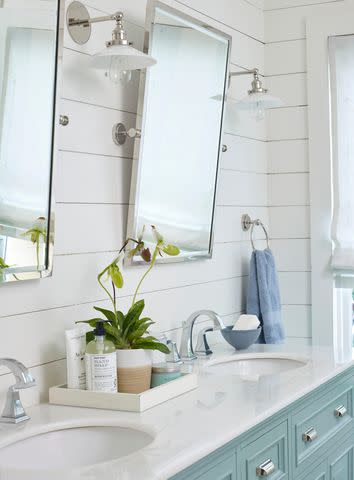
Whether you have a bathroom vanity or pedestal sink, your bathroom sink is often the first fixture you see when entering the room. And you can't hide sinks behind a shower curtain if the last occupant left them messy. So you'll want to keep them clean and shining, even if only to start each new day on a high note. Clean your bathroom sink with a general-purpose spray cleaner or a mixture of vinegar and water (one cup vinegar to one cup water).
For stubborn grime, scrub the bathroom sink with a mildly abrasive cleanser or a paste made from baking soda and water. Vinegar works well for removing soap scum. Dry the sink with a soft cloth to keep it gleaming. To help keep your bathroom sink clean, get in the habit of wiping down the basin and surrounding countertop when you're done getting ready or brushing your teeth for the day.
:Get the Full Tutorial for Bathroom Sink Cleaning
How to Clean the Bathroom Faucet
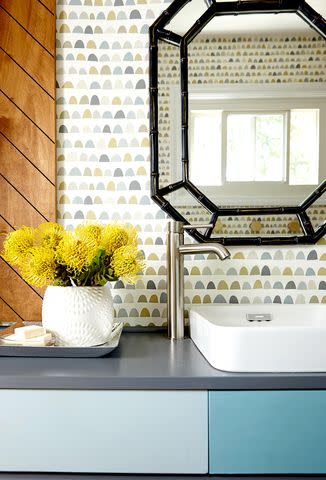
Dish soap, water, and a cleaning cloth are typically all you need to clean a bathroom faucet. However, you should always check the manufacturer's instructions first to determine the recommended cleaning method and tools for your faucet's material. Some finishes, such as oil-rubbed bronze or unlacquered brass, should only be cleaned with water and a soft cloth. Even for protected finishes, like chrome or stainless steel, avoid scrubbing with stiff-bristled brushes or abrasive sponges, as these could damage the faucet's finish. After cleaning the surface, wipe it down with a clean, dry cloth to buff the shine and prevent water spots.
For tough grime that won't budge with just soap, try cleaning your bathroom faucet with a solution of 1 cup vinegar to 1 cup water applied with a cleaning cloth. If you're not sure whether vinegar is suitable for your faucet's finish, test it in an inconspicuous area first. To clean around the edges of the faucet, use a toothbrush to gently scrub away grime. A small amount of baking soda with a few drops of water can also help clear away stubborn stains or buildup around the faucet.
:8 Simple Updates That Will Keep Your Bathroom Clean for Longer
How to Clean a Bathtub
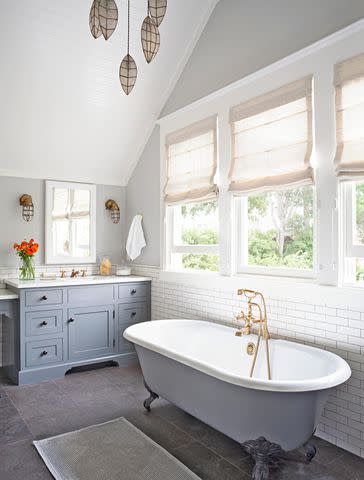
Porcelain or ceramic bathtubs should be cleaned with either a general-purpose cleaner, vinegar and water, or a paste made from baking soda and water. Never use undiluted bleach on a porcelain tub. Undiluted bleach can remove the finish on porcelain, which "pits" the surface, making it look and feel rough. Use a stain-removing cleanser on rust.
Acrylic and fiberglass tubs do not have pores in them so they're easy to keep clean with a small amount of dish soap and water. Wipe the surface of the tub with a soft cloth for ongoing maintenance. If you, or someone in your household, use bath oils, wipe down the tub immediately after bathing to avoid scum buildup.
:4 Simple Steps to Clean a Bathtub with Sparkling Results
How to Clean Showerheads and Faucets
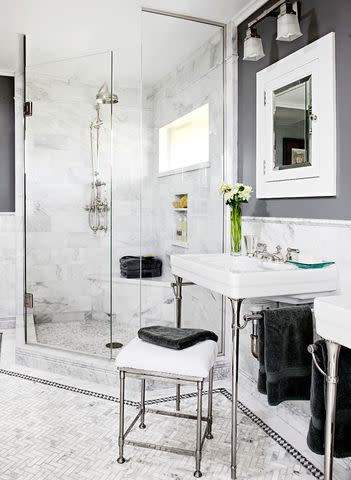
The best cleaning method for showerheads and faucets depends on the material. To remove lime from showerheads made with chrome, stainless steel, or other protected metal surfaces, fill a plastic bag with white vinegar. Attach the bag over the showerhead with a rubber band. Wait one hour, remove the vinegar bag and turn on the shower to flush away the vinegar and sediment. Polish with a soft cloth.
For fixtures with oil-rubbed bronze or brass finishes, the recommendation is that you use only water for cleaning. Refer to the manufacturer's care instructions since cleansers can damage a specialty surface. And if in doubt, always test a cleaning product on an inconspicuous part of the fixture so that any damage to the finish is hard to spot.
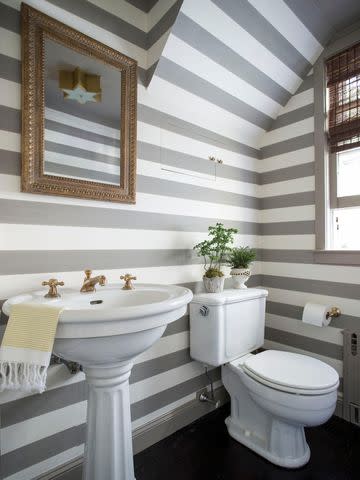
How to Clean the Toilet and Toilet Bowl
To clean your toilet, spray the exterior with a general-purpose cleaner or mixture of vinegar and water. Wipe clean. Use a mild cleaner such as dish soap with water to clean the surface of the toilet seat. Sanitize the bowl by scrubbing with antibacterial toilet cleaner or 1/4 cup bleach to 1 gallon of water. Wipe off any splashes or drips on the surrounding area with a soft dry cloth.
:How to Clean a Toilet for a Pristine Bathroom
false
